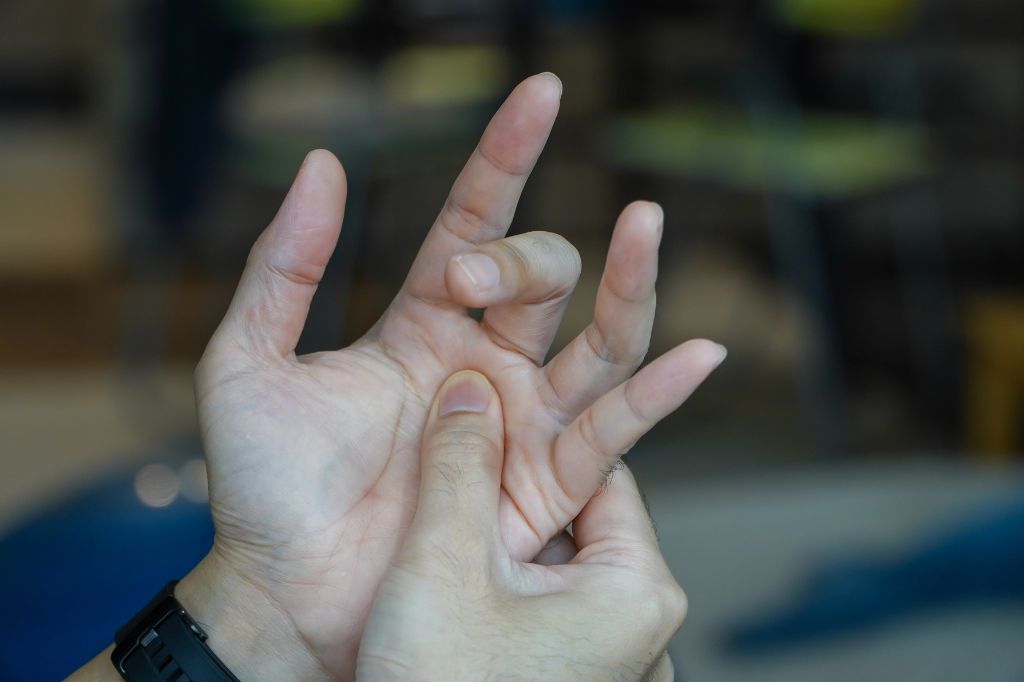
Trigger finger, also known as stenosing tenosynovitis, is a condition where your fingers get stuck in a bent position and may snap when straightened. This painful condition often results from inflammation of the tendons that control finger movement. At Orthopedic Specialty Institute (OSI), we offer both non-surgical and surgical treatment options to help manage trigger finger.
What is Trigger Finger?
Trigger finger occurs when the flexor tendons that control finger movements become irritated and inflamed, causing them to thicken and making it difficult for the tendon to glide smoothly through its sheath. This leads to the characteristic “catching” or “locking” of the finger when you try to bend or straighten it.
Causes or Triggers
- Repetitive Movements: Frequent, repetitive hand or finger movements can irritate the tendons, leading to trigger finger. Occupations or hobbies that involve gripping or using tools often contribute to the condition.
- Underlying Health Conditions: Certain medical conditions, such as diabetes and rheumatoid arthritis, increase the risk of developing trigger finger due to inflammation and tissue thickening around the tendons.
- Age and Gender: Trigger finger is more common in women, particularly those between the ages of 40 and 60.
Symptoms of Trigger Finger
- A clicking or popping sensation when moving the affected finger
- Stiffness in the finger, particularly in the morning
- Pain or tenderness in the base of the affected finger
- Inability to fully straighten the finger
- A visible bump at the base of the finger where the tendon sheath is inflamed
- Swelling in the affected area that may fluctuate throughout the day
Trigger Finger Exercises
While exercises may not cure trigger finger, they can help manage the symptoms and improve flexibility. Here are some exercises that may help alleviate the discomfort associated with trigger finger:
1. Finger Stretches
Hold your affected hand out in front of you, palm facing down. Use your other hand to gently lift each finger of the affected hand, stretching them upward. Hold each stretch for 15-30 seconds. Repeat this exercise 2-3 times daily.
2. Tendon Gliding Exercises
Start with your hand in a neutral position, fingers straight. Slowly bend your fingers into a hook fist (fingers curled but the thumb remains out), then into a full fist, and finally straighten them again. Repeat this sequence 10 times.
3. Finger Lifts
Place your hand flat on a table, palm down. Slowly lift each finger one at a time, holding it up for a few seconds before lowering it back down. Repeat 10-15 times per finger. This exercise helps to improve the range of motion and strengthens the tendons.
4. Grip Strengthening Exercises
Squeeze a soft ball or stress ball with your affected hand, holding the squeeze for a few seconds before releasing. Repeat 10-15 times. Strengthening the muscles in the hand can provide better support for the tendons, reducing the strain that leads to trigger finger.
5. Rubber Band Stretch
Place a rubber band around your fingers and thumb. Slowly spread your fingers apart, stretching the rubber band as far as comfortable, then slowly release. Repeat 10-15 times. This exercise strengthens the muscles around the tendons and can help prevent the finger from getting stuck.
Treatment Options for Trigger Finger
If exercises and home care don’t provide enough relief, it’s important to explore other treatment options with your orthopedic specialist. At Orthopedic Specialty Institute, we offer a range of treatments tailored to your specific condition.
Splinting
Splinting is a non-invasive treatment option where a splint is worn at night to keep the affected finger in a straight position. This helps to rest the tendon and reduce inflammation, giving the tendon time to heal. Splinting is particularly effective for mild to moderate cases of trigger finger, and many patients find significant relief with this simple intervention.
Medications
For managing pain and inflammation associated with trigger finger, over-the-counter pain relievers like ibuprofen or acetaminophen can be helpful. While medications alone may not resolve the condition, they are often used alongside other treatments to help alleviate discomfort and allow for easier movement of the affected finger.
Steroid Injections
Steroid injections are a common treatment for reducing inflammation in the tendon sheath. The injection is administered directly into the area around the affected tendon, which can help alleviate pain and allow the tendon to move more freely. Many patients experience significant relief from just one injection, although in some cases, additional injections may be necessary.
Physical Therapy
Physical therapy plays a crucial role in the treatment of trigger finger, especially when combined with other treatment options. A physical therapist can guide you through specific exercises designed to improve flexibility, strengthen the muscles around the affected tendon, and promote better tendon movement. This can reduce symptoms and prevent further irritation of the tendon. Physical therapy is often recommended as part of a comprehensive treatment plan, helping you regain full use of your hand and fingers
Percutaneous Release
For patients seeking a minimally invasive option, percutaneous release is a procedure that can be performed under local anesthesia. During this procedure, a needle is used to release the affected tendon from its sheath, allowing it to move more freely. This method offers quick recovery times and can be a very effective solution for many individuals with trigger finger.
Surgical Treatment
In more severe cases of trigger finger, where other treatments haven’t provided sufficient relief, surgical intervention may be necessary. During the surgery, a small incision is made to widen the tendon sheath, which allows the tendon to glide smoothly without catching. Surgery has a high success rate, and most patients experience full relief from their symptoms after the procedure.
Take Control of Trigger Finger Today
Trigger finger doesn’t have to limit your daily activities. With the right combination of exercises and treatments, you can regain mobility and reduce pain. At Orthopedic Specialty Institute, our team is dedicated to providing personalized care to help you find the best solution for your needs. If you’re experiencing symptoms of trigger finger, contact us today to schedule an appointment. Let us help you take the next step toward pain-free living and restored hand function.
